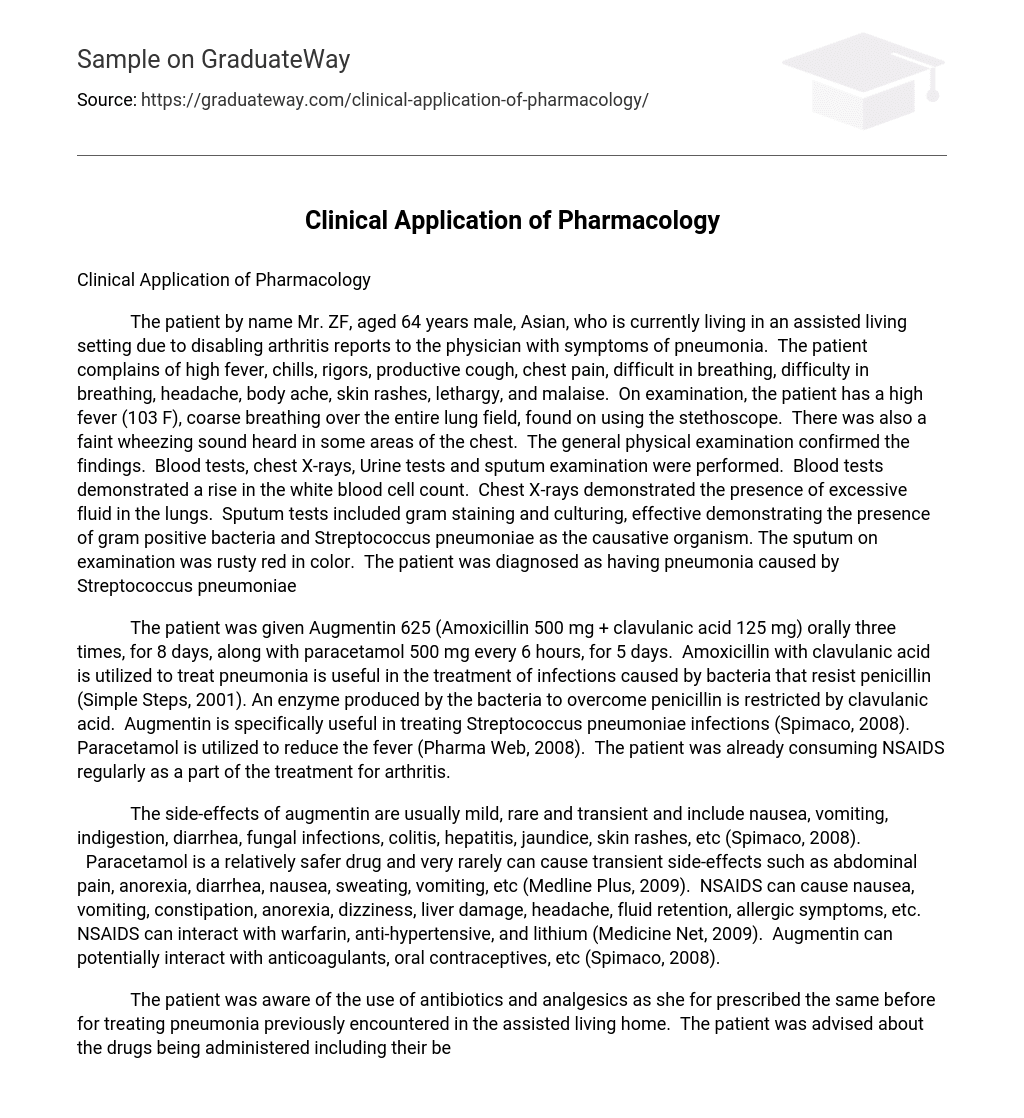The patient by name Mr. ZF, aged 64 years male, Asian, who is currently living in an assisted living setting due to disabling arthritis reports to the physician with symptoms of pneumonia. The patient complains of high fever, chills, rigors, productive cough, chest pain, difficult in breathing, difficulty in breathing, headache, body ache, skin rashes, lethargy, and malaise. On examination, the patient has a high fever (103 F), coarse breathing over the entire lung field, found on using the stethoscope. There was also a faint wheezing sound heard in some areas of the chest. The general physical examination confirmed the findings. Blood tests, chest X-rays, Urine tests and sputum examination were performed. Blood tests demonstrated a rise in the white blood cell count. Chest X-rays demonstrated the presence of excessive fluid in the lungs. Sputum tests included gram staining and culturing, effective demonstrating the presence of gram positive bacteria and Streptococcus pneumoniae as the causative organism. The sputum on examination was rusty red in color. The patient was diagnosed as having pneumonia caused by Streptococcus pneumoniae
The patient was given Augmentin 625 (Amoxicillin 500 mg + clavulanic acid 125 mg) orally three times, for 8 days, along with paracetamol 500 mg every 6 hours, for 5 days. Amoxicillin with clavulanic acid is utilized to treat pneumonia is useful in the treatment of infections caused by bacteria that resist penicillin (Simple Steps, 2001). An enzyme produced by the bacteria to overcome penicillin is restricted by clavulanic acid. Augmentin is specifically useful in treating Streptococcus pneumoniae infections (Spimaco, 2008). Paracetamol is utilized to reduce the fever (Pharma Web, 2008). The patient was already consuming NSAIDS regularly as a part of the treatment for arthritis.
The side-effects of augmentin are usually mild, rare and transient and include nausea, vomiting, indigestion, diarrhea, fungal infections, colitis, hepatitis, jaundice, skin rashes, etc (Spimaco, 2008). Paracetamol is a relatively safer drug and very rarely can cause transient side-effects such as abdominal pain, anorexia, diarrhea, nausea, sweating, vomiting, etc (Medline Plus, 2009). NSAIDS can cause nausea, vomiting, constipation, anorexia, dizziness, liver damage, headache, fluid retention, allergic symptoms, etc. NSAIDS can interact with warfarin, anti-hypertensive, and lithium (Medicine Net, 2009). Augmentin can potentially interact with anticoagulants, oral contraceptives, etc (Spimaco, 2008).
The patient was aware of the use of antibiotics and analgesics as she for prescribed the same before for treating pneumonia previously encountered in the assisted living home. The patient was advised about the drugs being administered including their beneficial effects, manner and duration in which consumed, steps to be taken in case of developing allergic symptoms or missing a dose, and also the side-effects of the drugs. The patient’s treatment was constantly monitored through the nurse and other healthcare professional, as worsening of the condition would require immediate use of Oxygen therapy, IV fluids and mechanical aid for breathing. The patient was also informed about the potential of developing serious side-effects of the drugs and informed about the immediate measures that need to be taken.
References
Medicine Net (2009). Nonsteroidal Antiinflammatory Drugs (NSAIDs), Retrieved on March 21, 2009, from Medicine Net Web site: http://www.medicinenet.com/nonsteroidal_antiinflammatory_drugs/article.htm
Medline Plus (2009). Acetaminophen overdose, Retrieved on March 21, 2009, from Medline Plus Web site: http://www.nlm.nih.gov/medlineplus/ency/article/002598.htm
Simple Steps (2001). Amoxicillin with Clavulanic Acid, Retrieved on March 21, 2009, from Aetna Dental Web site: http://www.simplestepsdental.com/SS/ihtSS/r.WSIHW000/st.32228/t.32718/pr.3.html
Spimaco (2008). Augmentin, Retrieved on March 21, 2009, from Spimaco Web site:
http://www.spimaco.com.sa/arabic/products/licenbrands/augmentin.htm





